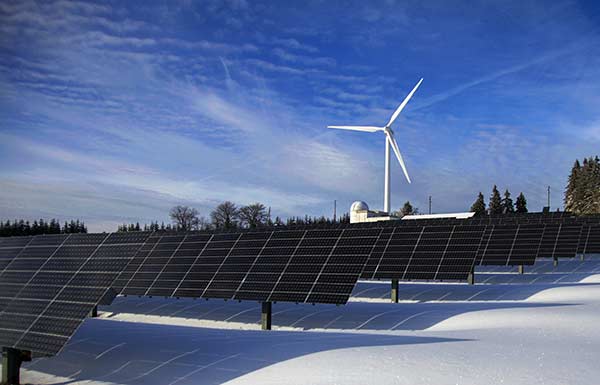RESS 2 & Hybrid Projects
- Szczegóły
- Utworzono: piątek, 08, październik 2021 15:24

Hybrid projects and energy storage in the context of the second auction for government subsidies under RESS.
RESS – A Brief Overview
Ireland, through the Department of the Environment, Climate and Communications (the Department) developed the Renewable Electricity Support Scheme (RESS) to commission new renewable electricity generation in order to meet the country’s commitments to reduce CO2 emissions. Under the 2019 Climate Action Plan, Ireland aims to generate 70% of its electricity through renewable energy by 2030. RESS subsidies (through two-way contracts for difference) are obtained by prospective generators bidding into competitive auctions that are delivered by the Department with the support of EirGrid and Commission for Regulation of Utilities.
RESS 1
Auction results:The first auction under RESS (RESS 1) was held in 2020. 114 projects participated in the RESS 1 qualification process with 109 qualifying to take part in the RESS 1 auction. Out of the 109 projects, 82 were deemed successful. The successful projects were either onshore wind or solar.
Solar: RESS 1 was a watershed moment for the Irish solar industry. This was the first government support scheme for commercial solar generation and of the 82 projects deemed successful 63 were solar projects (representing 763MW of new generation capacity). On foot of RESS 1, and in anticipation of the next RESS auction (RESS 2), MacSweeney & Company has advised and is advising on the coordination and delivery of several solar schemes as this technology is rolled out at a grid scale across Ireland.
RESS 2
Proposed Timetable: The Department published the draft RESS 2 Terms and Conditions in June 2021. Under the preliminary RESS 2 auction timetable, the window to apply to qualify for the RESS 2 auction will run from 29 March to 29 April 2022 and it is intended that the RESS 2 auction will take place on 29 July 2022.
Proposed Terms and Conditions: The draft RESS 2 Terms and Conditions are largely consistent with those of RESS 1, though there are some notable points of difference, such as a new minimum investment requirement which prescribes an investment equal to or exceed €300 per kW of capacity in order to qualify for the subsidy.
The key difference in the draft RESS 2 Terms and Conditions that we consider here is the introduction of “hybrid projects”, specifically through three new categories of technology that is eligible for subsidies: (i) RESS Hybrid Wind and Storage, (ii) RESS Hybrid Solar and Storage, and (iii) RESS Hybrid Wind and Solar.
RESS 2 – Electricity Storage and Hybrid Projects
“Hybrid Projects” refer to projects that incorporate either:
- wind and solar generation facilities in the same project (Hybrid Generation); or
- wind or solar generation facilities, along with an energy storage technology such as a battery (Hybrid Storage).
Background: The inclusion of Hybrid Projects in the list of technologies that will be eligible for subsidy under RESS 2 ties in with the FlexTech Integration Initiative that is a part of the energy strategy of EirGrid and SONI (the operators of the transmission systems on the island) and the Hybrid Working Group that has been set up to promote the initiative.
Rationale: Until recently, onshore wind represented virtually all of Ireland’s variable renewable generation capacity. The improvement of the diversity factor of generation on the Irish grid, in the most efficient manner possible, is an important goal of the Hybrid Working Group and it is of particular relevance in the context of spiking electricity prices across Europe in recent weeks, and low wind globally in 2021. Co-location of wind and solar generation can maximise the use of transmission/distribution infrastructure and the locational energy mix, while batteries can take in energy produced at times of low demand (e.g. late at night for wind) and release energy at times when demand and electricity prices are higher. At MacSweeney & Company we are already seeing client’s incorporating a mix of solar and wind generation on new projects.
Proposed Options for Hybrid Storage: the draft RESS 2 Terms and Conditions propose that developers of Hybrid Storage projects who wish to be considered in the RESS 2 application process will have two options in their RESS 2 Application for Qualification.
- Under Option 1, only the renewable generation portion of the facility (i.e. the wind farm or solar farm) is considered as being the RESS 2 Project; and the storage component is separate and not part of RESS and the project owner can use the battery as it chooses e.g. to provide DS3 services. It is important to note that this will leave a generator exposed to negative pricing risk (no subsidy is paid under RESS when prices are negative) and potentially curtailment risk and constraint risk. The generation portion of the facility will have its own meter so that the subsidy can be accurately calculated.
- Under Option 2, the entire hybrid project, both generation and storage, sit behind the same RESS 2 meter. Thus, the generation charges the battery internally and not via the grid. Thus, if prices are negative, the energy can be diverted from the generation facility to the battery and potentially released again from the battery when prices are positive. As such, support and difference payments would all be based on the one meter at the grid connection point. This approach will allow generators to manage their negative price exposure and it also has the benefit of ensuring that only green electricity is exported from the project site.
Contributed by Ailish Morrissey & Colm Booth
Key Contacts:


